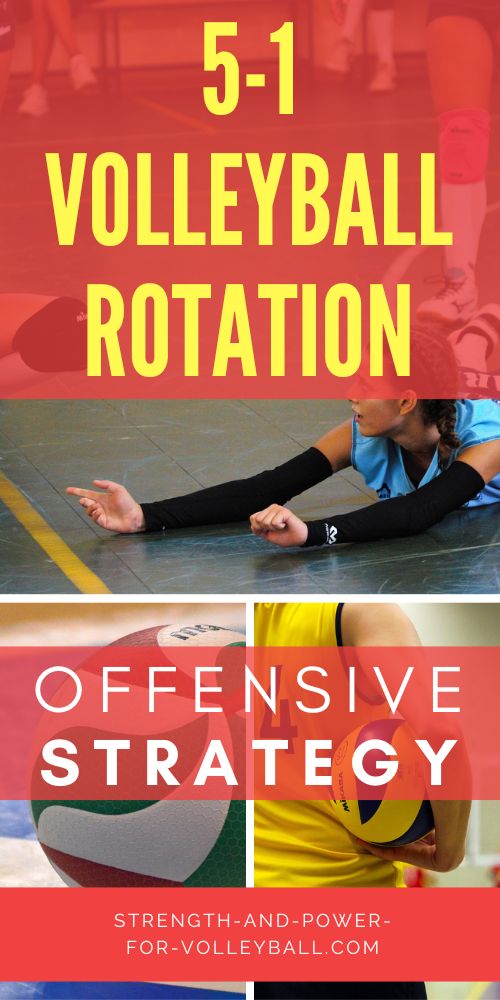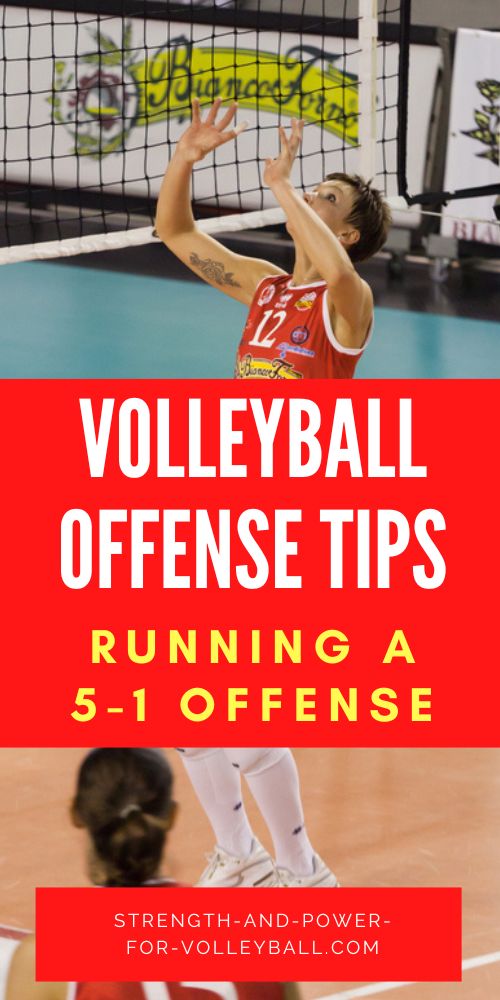5 1 Volleyball Rotation
Line Ups and Offensive Strategy
5 1 volleyball rotation tips for running a 5-1 offense. Learn how to line up on the court and the best strategies for running a 5-1.
Why a 5 1 Volleyball Rotation?
The 5-1 rotation is when you have one setter and 5 attackers. The setter sets in every rotation. This means the setter will set when on the front row.
You have 3 front row players in each rotation. When running a 5-1, the 5 positions on the court other than the setter will be attackers when on the front row.
When the setter is on the back row, you have 3 attackers on the front row. When the setter is on the front row, the setter has two front row attackers to set.
There are many advantages of running a 5-1 offense.
Advantages of the 5-1 Rotation
Only need one setter. When running a 5-1, the coach only needs to focus on working on one setter. This can make things less complicated when only needing to focus on improving the skills of one setter.
Setter develops skills faster. When using just one setter, this player will get more reps and more experience than when having 2 or 3 setters on the team.
Line ups are easier. It's easier for the team to line up in serve receive when the setter is front row. When front row, the setter is near the net ready to receive a pass. When the setter is back row, it can be more difficult to get the passers lined up to receive the serve. Also, when the setter is front row, the setter isn't as big a part of defense. When on the back row, if the setter makes the defensive play, another player needs to step in a set. This can make things much more difficult if your team struggles running an offense out-of-system with a non-setter setting the ball.
Easier to Run a Slide. When the setter is front row, it can be easier to have the middle run a slide. Only two attackers at the net can really simplify the offense. There's less congestion with just 2 attackers instead of 3.
The setter can attack at the net. With the setter is on the front row, the setter can be used as an offensive weapon and attack the second ball. Plays can be run to pass the ball tight to draw the block to the setter. The setter could then have the option to attack the ball or set. If the blocker commits to staying with the setter, there's an opportunity to set an attacker for a one on one attack. You may even end up drawing multiple blockers to stay with the middle and setter and end up with an open net for the outside attack.
The team can pass tight when setter is front row. When running a 6-2, a team can get into trouble by passing the ball too tight to the net. This is because the setters in a 6-2 are always back row players. Back row players can't attack at the net. So, if the ball is passed tight to the net, the back row setter needs to avoid sending the ball over the net (when contacting the ball with the entire ball above the top of the net). Basically, the 6-2 setters need to be concerned about being called for illegal back row attacks. Front row setters won't need to worry about this. In fact, the front row setter can use this situation to their advantage by deceiving the opponent, drawing the blocker and making it more difficult for the opponent to predict where the ball will be sent (attacked on 2 or set to an attacker).
There are some disadvantages of the 5-1 offense.
Disadvantages of the 5-1 Rotation
You won't always have 3 attackers on the front row. With a 5-1, the setter will be front row for 3 rotations. If the 2 attackers on the front row are struggling to put the ball away, this could be a problem for the offense. The setter should develop skills for attacking on two to help mitigate this situation. Also, it's a good idea to have the best attacker next to the setter in the line up so the setter has good attackers to set when on the front row.
If the setter is struggling, you don't have an experienced replacement. If the setter struggles, you can't easily adjust the line up. You'll need to sub in a new setter. A big disadvantage is when you have the same setter set all the time, the back up setter won't have nearly as much experience. This can really hurt a team if the back up setter needs to sub in to replace the setter. The advantage of the 6-2 offense is that you have two setters getting a lot of experience. When one setter struggles, the other setter can step up and fill in.
Line Ups for a 5 1 Volleyball Rotation
For the rotations when the setter is on the back row, the line up is the same as the 6-2 serve receive. When the setter is on the front row, the line up is easier because the setter is closer to the target area.
For example, when the setter is left-front, the setter just needs to stay closer to the left side line than the middle front.
When the setter is middle front or right front, the setter is really close to the target area and there isn't much concern for overlap.
Offensive Strategies for a 5 1 Volleyball Rotation
The offensive strategy for running a 5-1 is more dynamic than when runnning a 6-2.
Since the setter is front row for 3 rotations, the setter should learn how to attack the 2nd ball. The team should also be aware of the situations where the setter is front row and the team should learn to pass the ball tighter to the net in these situations.
Passing the ball tight to the net when the setter is front row will give the setter more options for how to attack the opponent.
If you enjoyed these tips and would like to keep it close to you at any time, just save this pin to your Pinterest Volleyball Training Board.

